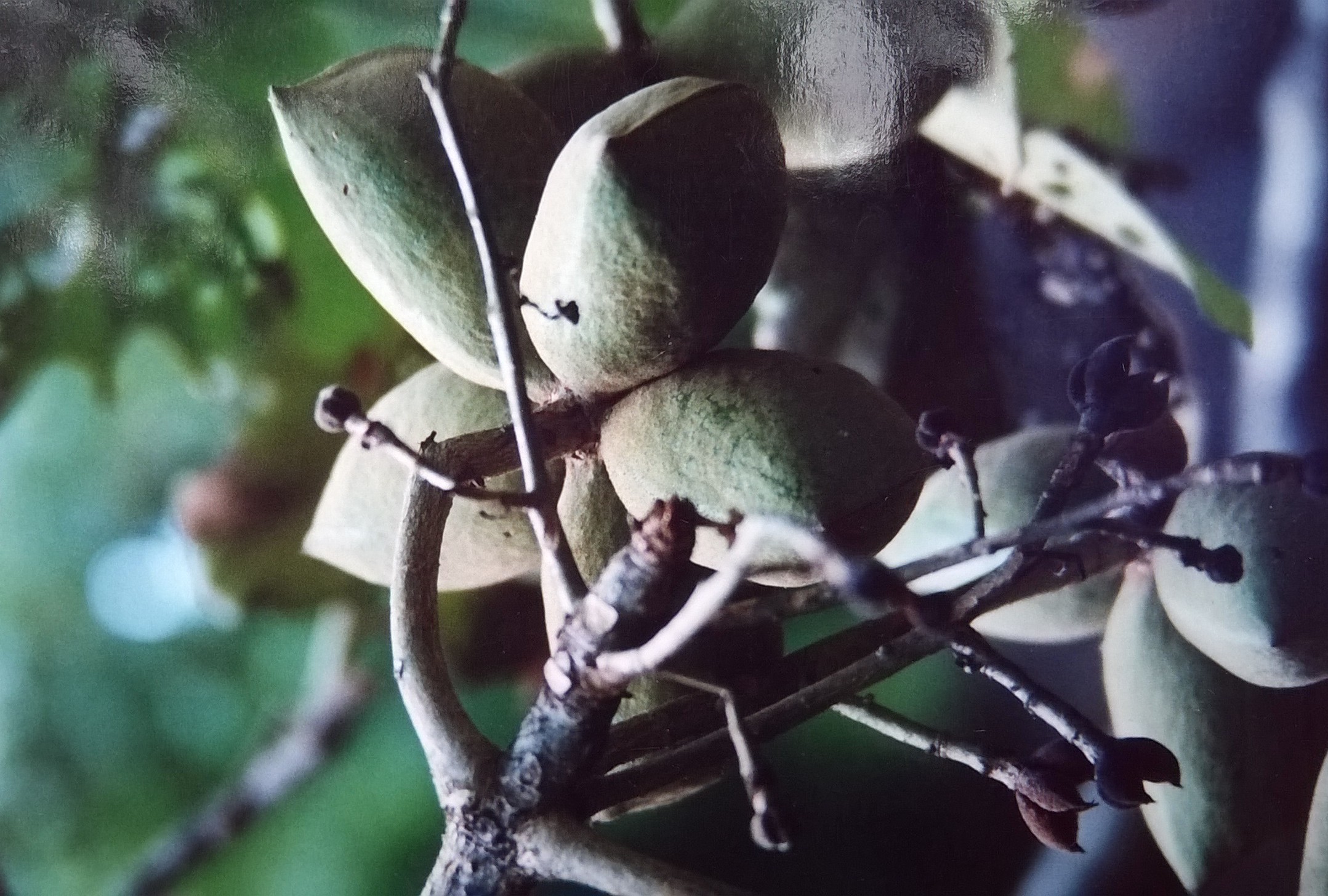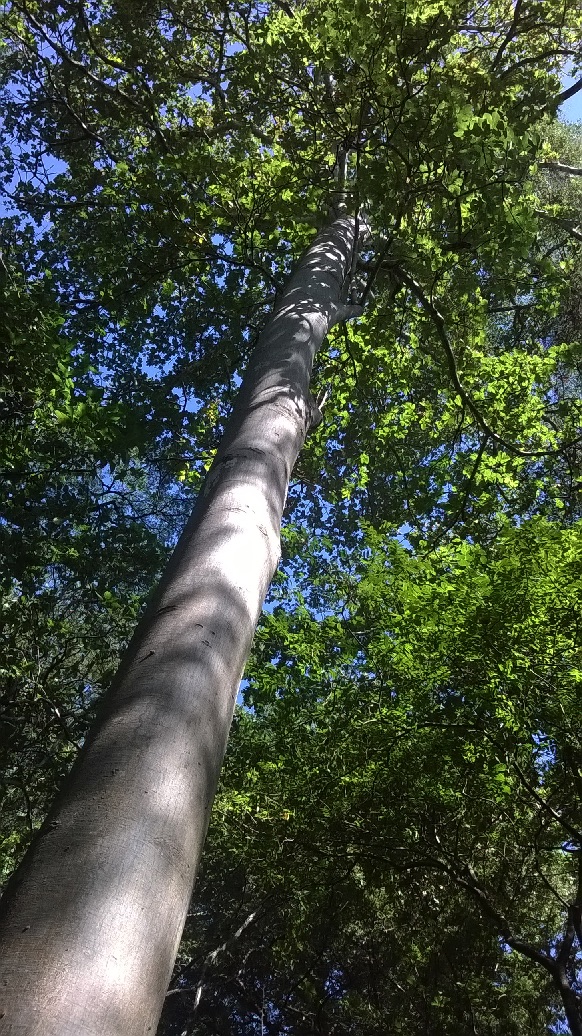Sterculia apetala (Jacq.) Karst.
Sterculiaceae PANAMA
Common evergreen (or briefly deciduous) canopy tree (25-35 m). In possession of a bulky, smooth-barked bole, unusually large, pleated leaves, high, prominent buttresses and a voluminous, extended crown, Panama is a magnificent tree species and a unique component of the tropical forest. Panama trees tend to prefer drier ecosystems (they are largely absent from the nearby but wet Osa Peninsula) – perhaps even drier than those found in Manuel Antonio, a possibility that might explain the predominance of this species along the excessively drained, sandy soils of the immediate coastline. An unusually dynamic tree (if one can apply that term to a member of the plant kingdom), Panama is nearly always in some stage of leaf renewal, floweration, or fruit production – with all three events often occurring simultaneously.
Description: Panama has a cylindrical and straight – truly columnar – trunk (measuring 1 m or more in diameter) whose base is fortified by thick, tall (1.5 m) buttresses. Clad in grayish – or even slightly pink – bark, the bole’s surface is smooth and intact, with no signs of scaring or exfoliation. Massive limbs, restricted to the upper fifth of large trees, extend laterally for many meters, creating a very broad, rounded canopy. The divergence and subdivision of these great limbs into smaller branches is limited, reducing the number of twigs and giving the tree a relatively open and well-lit crown.
Foliage grows only from the ends of the thick, stubby twigs, and it is clustered in whorl-like arrangements at these locations. Simple and alternate, Panama leaves are very distinctive in size and shape. First, they are large, with blades measuring 25 cm in length found at the ends of 15 cm petioles. Second, leaf blades are deeply lobed and have a form vaguely reminiscent of Maple leaves. Third, several distinct creases cause the blades to fold, making them three-dimensional, space-filling structures. (In a tree where branching is minimal, this latter feature may enable Panama to make more efficient utilization of its crown space.) Leaf faces, especially under-surfaces, are covered with large amounts of short, fine pubescence. At least semi-annually, Panama trees shed their foliage cover completely and then rapidly regenerate it: once during the middle of the wet season (July-October) and again only a few months later in the early dry season (November-February). However, the timing of these events lacks precision and individual Panama trees show little synchronicity, allowing different trees to be observed in the process of crown renewal seemingly sporadically – at nearly anytime during the year.
Flowers usually emerge during the same growth spurts that generate new foliage, so flowering periods share their frequency, poor precision, and lack of synchronicity with these latter events. Panama blossoms, borne on long racemes (20 cm), begin as greenish, spherical buds marked by contrasting, maroon pubescence. Distally, each bud is divided into five, wedge-shaped, fleshy sepals that curl backwards as the flower opens, forming a petalless, deeply-cupped, star-shaped blossom (3 cm). Largely creme colored, the wrinkled, inner surface of the flower is highlighted with maroon and sports a bright yellow center. A single, central pistil, curved and hook-shaped, carries a small ball at its tip. Panama flowers are fragrant and their maple-like odor is often notable from the ground. The period of most intense flowering activity lasts from January to April, with all trees participating for about three weeks of this protracted interval. A second, lesser event occurs from August to October. Dead and dried flowers often persist in the crowns and on the forest floor for weeks after these fertile episodes.
Within a couple of months of flowering, fruits become visible high in the canopy. They initially resemble small (1 cm) knobs, positioned at the ends of stiff, twig-like pedestals. For the following six months, fruit development appears to stagnate, for there is little external change notable from the ground. Finally resuming rapid growth, the fruits become full sized, woody pods (10 cm by 6 cm) some ten months after flowering has ceased. (They begin to harvest only after a full year has passed). Clustered in heads numbering from 1 to 7 (usually 3-5), the pods are arranged in a radially-symmetrical whorl (spoke-fashion) around the supporting pedestal. As they desiccate in the dry season sun, the pods ripen and their velvety skins turn from green to maroon or brown. Eventually, each pod ruptures along a longitudinal seam and twists open, revealing a stunning, bright orange-yellow interior. Do not be deceived – though attractive, this inner surface is lined with innumerable, fine (almost invisible), sharp, glassy spines. With no more than the slightest touch, dozens of these irritating, fiberglass-like shards puncture and the skin and cling to it – becoming nearly impossible to see, much less remove! Five or six football-shaped, black seeds (2.5 cm by 1 cm) are anchored to the edge of the pod along the open seam. Each is covered with a thin, black, fleshy aril.
Harvests occur annually, between January and early May, though their intensity varies from year to year. Individual trees participate for only about one month of this time. (Although there are two distinct flowering periods, there only appears to be one long harvest – possibly representing the combined and overlapping fruiting periods produced by both fertile episodes). Eventually, the ground becomes littered with spent pods, months being required before they all finally disintegrate. Panama seeds germinate easily, and a blanket of large, lobe-leafed seedlings may be observed on the forest floor underneath these trees after the first drenching rains of May and June.
Similar Species: The very large size of the Panama tree, coupled with its very unusual, lobed and creased leaves, make it a unique and unmistakable species.
Natural History: Bees and other members of the Hymenoptera family of insects are the likely pollinators of Panama flowers. Flies – attracted to the maroon hue of the blossoms – may play a role as well (Croat, 1978). White-faced monkeys have been observed devouring the aril around Panama seeds. Showing considerable dexterity – and daring – these mammals seem very willing to snatch Panama seeds from their spine-laden pods. This observation is made more poignant since, lacking tweezers and antibiotics, an infected, spine-induced injury would represent a potentially life-threatening situation for any unfortunate monkey.
Chewing on the fruits and then spiting out the (sometimes damaged) pits – monkeys (and probably other arboreal animals) disperse Panama seeds. During particularly heavy harvests, when a troop of monkeys is foraging in a tree, a slow but steady rain of seeds can be heard as they cascade down to the ground through the foliage. Certain kinds of parrots (Brown-hooded) and parakeets (Orange-chinned), prey on the seeds themselves, using their strong bills to break the testa and reach the nutritious embryo within. Obviously, such behavior does not help disperse viable seeds and must be classified as predatory or even parasitic.
Leaf hairs reduce the flow of air over blade surfaces, decreasing the evaporation of water from epidermal tissues and stomas. Thus, Panama’s thick, pubescent leaves probably help it conserve water during times of drought – an adaptation that also enables this tree to survive in sandy, beachside soils. The folded, three-dimensional nature of Panama blades helps to generate a fuller crown, perhaps partially compensating for the lack of extensive branching seen in this species. Leathery and thick, dead Panama leaves are resistant to decay, and they often form a persistent, ground-blanketing layer on the forest floor. Since Panama leaves are shed at the beginning of the dry season, it is interesting to speculate whether this might not be an adaptation intended to help conserve ground moisture by reducing evaporation from the soil surface. Perhaps significantly, the only other large-bladed leaf species present in Manuel Antonio (Brosimum utile and Terminalia catappa) exhibit similar leaf-shedding behavior.
Uses: Panama seeds are edible and can be toasted to improve their flavor. Allen states that they are used to produce oil in some countries of the region. Not highly prized, Panama wood is soft and light.
Distribution: Panama trees can be seen along the sandy coastline and, more rarely, in the primary, interior forests. There, it prefers the better-drained soils of slopes and crests. Allen (1956) reports that the tree is very common in the lowlands of Chiriqui Province, Panama – perhaps helping to explain why this country took its name from the Panama tree. The species ranges from Mexico to Peru and Brazil and is present in the West Indies.
Photos: Tree Tree2 Tree3 Trunk Trunk2 Trunk3 Leaf Flower Flower2 Flower3 Fruit Fruit2 Fruit3







